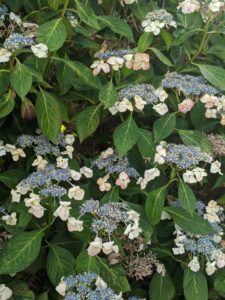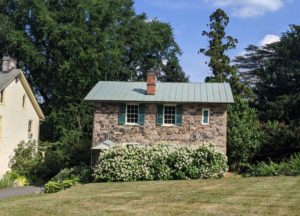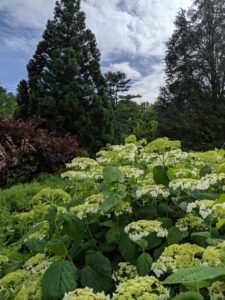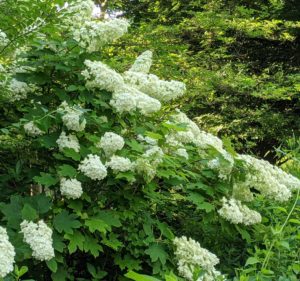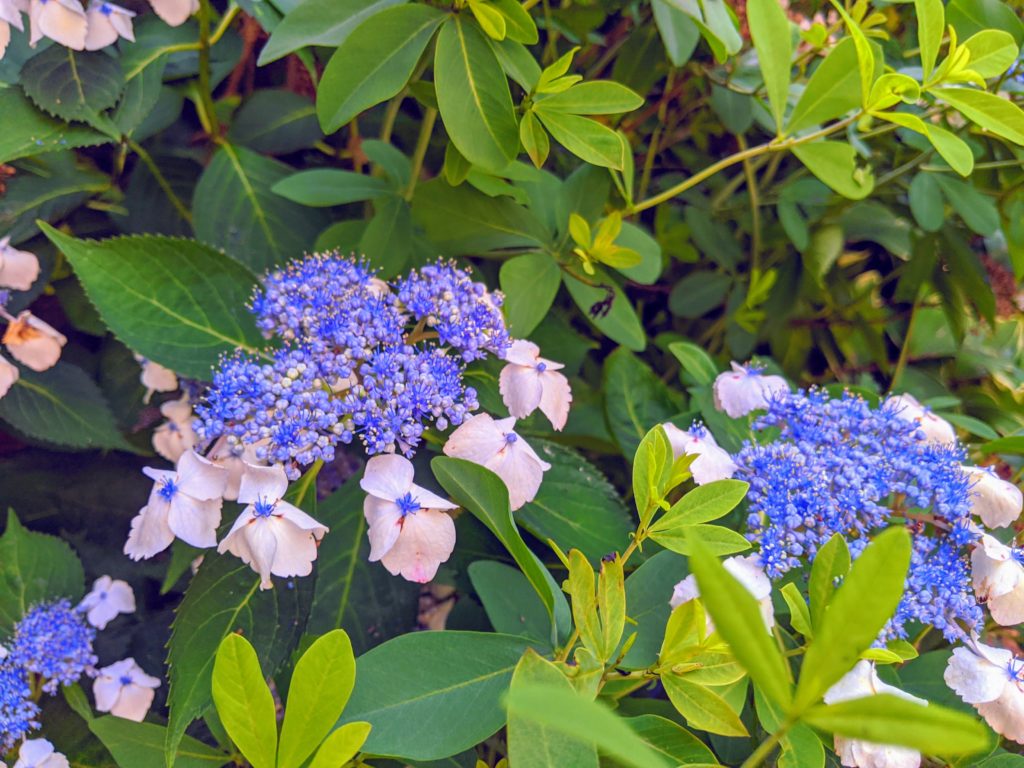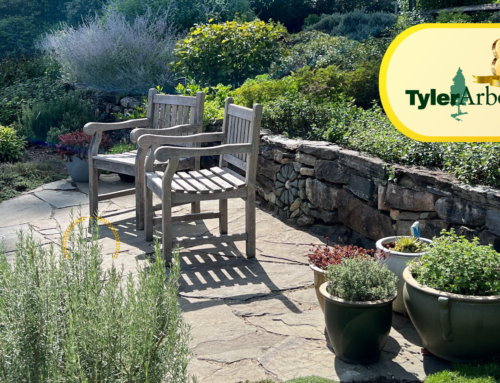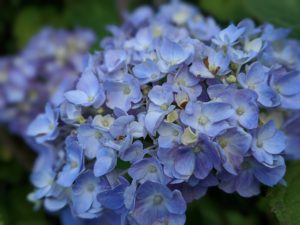 Growing up, I remember mom would be out in the yard tending to her beloved giant hydrangeas with their platter-sized, blue, mopheads. Later as I was attending horticulture classes, she asked whether it was true that she could change the color of the hydrangea flowers by simply changing the pH of the soil in which it was growing. Yes mom, acid soil makes the flowers blue and alkaline soil makes the flowers pink. That was 30 years ago. Since then, the world of hydrangeas has grown exponentially and more species and varieties are grown not only for the flowers, but also for foliage and for our pollinators. There’s practically an hydrangea for any sun, semi-shaded or shade garden. Here’s Tyler’s round-up.
Growing up, I remember mom would be out in the yard tending to her beloved giant hydrangeas with their platter-sized, blue, mopheads. Later as I was attending horticulture classes, she asked whether it was true that she could change the color of the hydrangea flowers by simply changing the pH of the soil in which it was growing. Yes mom, acid soil makes the flowers blue and alkaline soil makes the flowers pink. That was 30 years ago. Since then, the world of hydrangeas has grown exponentially and more species and varieties are grown not only for the flowers, but also for foliage and for our pollinators. There’s practically an hydrangea for any sun, semi-shaded or shade garden. Here’s Tyler’s round-up.
You need not be a botanist to know that there are many different hydrangeas simply by how they look. Here’s an easy breakdown. The traditional round headed hydrangeas are Hydrangea macrophylla also known as bigleaf hydrangea, which originates from Japan where it’s been revered for thousands of years. New hydrangeas developed from the classic mop heads and they are the lacecaps, and their flowers are more delicate and subtle. Hydrangea macrophylla have flowers in the blue, pink and white range and these flowers are from last year’s wood. Please keep this in mind for care! One drawback about this grouping is that hardiness is an issue in this area. As the flower buds are developed from the previous year, any damage during the winter from cold temperatures would undermine the bloom show. A recent development in the hydrangea world is the Endless Summer series; hydrangeas that rebloom throughout the summer. These hydrangeas bloom both on last year’s wood and the current year’s wood.
One hydrangea that is very hardy and tough in our area is the panicle hydrangea, Hydrangea paniculata. I’ll admit it, I’ve cut these shrubs to the ground many times to have them pop right back up with bigger flowers. The variety ‘Tardiva’ has grown to a massive 10’ wide and 8’ tall in my backyard. Limited to white, cream and now pink flowers, the panicle hydrangea is the most sun tolerant of all the hydrangeas. The cultivated variety ‘Limelight’ with its chartreuse summer flowers is an easy addition to any garden, particularly to the summer border. In late summer, the flowers will turn an antique pink. At Tyler, we have ‘Little Lime’ which is a smaller variety growing in the Barn Garden.
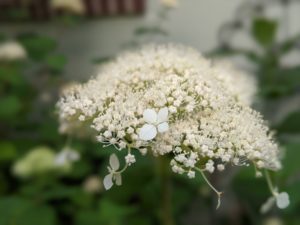 The next two species of hydrangeas are from North America; smooth hydrangea, Hydrangea arborescens and oakleaf hydrangea, Hydrangea quercifolia. According to our plant records, we have planted over 40 smooth hydrangeas in the Native Woodland Walk, Barn Garden, parking lot, Lucille’s Garden and even in the Maze. We like this plant. The native smooth hydrangea is easy to maintain and it flowers on the current year’s wood. It will flower without fail. The wild smooth hydrangea, pictured to the left, looks very different from other hydrangeas. Hydrangea flowers are actually a cluster of smaller flowers. Some are fertile and some are sterile. What we think are 4-petaled flowers are actually modified leaves called sepals. The showy sepal flowers are infertile and do not produce pollen or nectar. It is the insignificant florets that produce pollen. Remember the mop head hydrangeas? You are looking at infertile flowers and they will not support pollinators, but lace caps and smooth hydrangeas will.
The next two species of hydrangeas are from North America; smooth hydrangea, Hydrangea arborescens and oakleaf hydrangea, Hydrangea quercifolia. According to our plant records, we have planted over 40 smooth hydrangeas in the Native Woodland Walk, Barn Garden, parking lot, Lucille’s Garden and even in the Maze. We like this plant. The native smooth hydrangea is easy to maintain and it flowers on the current year’s wood. It will flower without fail. The wild smooth hydrangea, pictured to the left, looks very different from other hydrangeas. Hydrangea flowers are actually a cluster of smaller flowers. Some are fertile and some are sterile. What we think are 4-petaled flowers are actually modified leaves called sepals. The showy sepal flowers are infertile and do not produce pollen or nectar. It is the insignificant florets that produce pollen. Remember the mop head hydrangeas? You are looking at infertile flowers and they will not support pollinators, but lace caps and smooth hydrangeas will.
You need not choose showy flowers over supporting pollinators. Let me introduce you to ‘Haas Halo’ smooth hydrangea. This shrub is outstanding in every way. It requires very little care except for watering during the first year of establishment. The flower heads are large, lacy and attract lots of pollinators. It is still on my must have plant list. You will find them at the Barn Garden just below the retaining wall. This is a recently developed variety and may not be readily found in the market. Other varieties such as ‘Annabelle’ and ‘Dardom’ are tucked in the Native Woodland Walk.
The oakleaf hydrangea, Hydrangea quercifolia, is an all-season shrub. In the heat of summer, large trusses of flowers that somewhat resemble those of the panicle hydrangea but much coarser, are in full show. If you look closely, the infertile flowers are masking the fertile flowers, which are underneath. Not to worry… the pollinators will find the fertile flowers. Unlike the other hydrangeas, the oakleaf hydrangea will put on a fall show of copper, orange and burgundy foliage. Like its name indicates, the foliage resembles those of oaks. Oakleaf hydrangeas that are growing in sunnier conditions will color up more. In the winter, the peeling bark is a great distraction. At Tyler, the predominant variety is ‘Snow Queen’, a regal oakleaf hydrangea with flower heads that are up to 12” long. For small gardens or even in planters, plant ‘Sikes Dwarf’, which only reaches 2‘- 3’ instead of over 8’.
Whether you have a large garden or just a patio, you can add hydrangeas for beauty and for pollinators. Remember that hydrangeas are not drought tolerant and prefer to be mulched. You should plant hydrangeas in shade if your garden is dry. Visit your nursery or Tyler’s plant sale; I’m sure we have a few hydrangeas you would like. The more you know, the better you grow!


